Physical Address
304 North Cardinal St.
Dorchester Center, MA 02124
The authors are indebted to Dr. Hulya Sahin Ozkan, Dr. Kerem Ozcan, and Ms. Rhonda Everett for their extensive contributions in the preparation of this chapter.
Neuroendocrine cells in the gastrointestinal (GI) tract altogether constitute the largest endocrine system in the body. In addition to functioning as endocrine cells they have distinctive properties; they also show autocrine, paracrine, and local neuromodulatory effects. They contain neurosecretory granules at the ultrastructural level, and some exhibit neuron-like cell processes. Thus they exhibit features of both conventional endocrine cells and neural cells, also reflected in the neoplasms derived from these cells. Therefore the term neuroendocrine (NE) is preferred to distinguish them from other endocrine cells, such as those of the thyroid, adrenal, or pituitary glands.
The NE system of the GI and pancreatobiliary tract is heterogeneous. There are at least 14 different cell types that are responsible for the production of more than 30 peptide hormones and bioamines. Enterochromaffin cells, the most abundant and the presumed origin for most neuroendocrine tumors (NETs), communicate with the crypt/gland lumen, and it is presumed that their tumorigenesis may be partly facilitated by the luminal milieu. At the same time, they are also oriented to secrete their products basally toward the vessels, and NETs of these cells often lead to secretory syndromes, such as carcinoid syndrome (see later). In contrast, enterochromaffin- like (ECL) cells occurring in the stomach do not communicate with the lumen, but instead respond to circulating or local hormones. The neoplasms of NE system in the GI tract have traditionally been divided into foregut, midgut, and hindgut categories; however, this is not of much practical use today in surgical pathology because of the elucidation of more organ-specific characteristics of NETs, as discussed later.
Tumors of the NE system are often designated by the hormone they secrete as functional NETs (e.g., gastrinoma, insulinoma). However, this is not based on immunohistochemical expression, but rather serological activity and consequent clinical manifestations. For example, strong immunohistochemical expression of gastrin in a NET is not considered sufficient to diagnose gastrinoma unless it is also clinically functional. One exception is ampullary and duodenal somatostatinomas in which there are no measurable circulating levels of somatostatin. Additionally, tumors can secrete different hormones during the course of the disease, further complicating hormone-based classification. Along the same lines, although the specific type of a functional NET can have some loose association with specific histological patterns, these associations are not very consistent, are rather nonspecific, and have no proven significant value in today’s practice, with a few exceptions discussed later.
The terminology for NE neoplasms has always been somewhat problematic. For well-differentiated tumors of the GI-tract, the term carcinoid tumor has been widely employed for more than a century, although even then some authors were advocating restriction of the term carcinoid to serotonin-producing NETs. The term carcinoid is now abandoned and replaced with well-differentiated neuroendocrine tumor. , , Similarly, pancreatic tumors were previously designated as islet cell tumors or pancreatic “endocrine” neoplasms. Currently, the preferred term, also endorsed by the World Health Organization (WHO; 2017, 2019, and 2021) , , is (well-differentiated) neuroendocrine tumor, which must be morphologically distinguished from poorly differentiated NE carcinomas such as small cell carcinoma and large cell NE carcinoma. The designation as a well-differentiated neuroendocrine tumor (WDNET) is independent of the stage of the neoplasm, which represents a change from the WHO 2000 and WHO 2004 classifications, which had advocated the term well-differentiated neuroendocrine carcinoma for WDNETs with metastases. The term carcinoma is now reserved only for poorly differentiated (high-grade) cancers with an overt NE pattern. Accordingly, even in metastatic sites, the neoplasms that were previously called carcinoid or islet cell tumors are designated as metastatic neuroendocrine tumors, not carcinomas, although technically speaking they are malignant neoplasms of epithelial nature (i.e., carcinomas).
It is now widely agreed upon that, other than the incipient neoplasms (tumorlet-type lesions) discussed separately later in this chapter, all WDNETs are best considered malignant neoplasms. Low-grade and early-stage neoplasms often follow a protracted or even benevolent clinical course if completely resected. Until recently, some authors had classified these low-grade, early-stage examples as benign (adenoma). In contrast, other investigators have maintained that even the rare occurrence of metastasis is an adequate sign of malignant potential, and they have proposed to classify the entire spectrum of NETs as carcinoma . It should be noted here that the fact that resected small (low-stage) and low-grade WDNETs are often cured by surgical removal does not necessarily mean they will behave as benign if they are not resected. As the experience with the long-term behavior of these tumors improved in the past few years, it has become clearer that WDNETs may be even more aggressive than previously thought once the hyperplastic precursor type lesions are excluded. Regardless, they remain clinically, pathologically, and genetically distinct from poorly differentiated NE carcinomas.
The identity and definition of poorly differentiated neuroendocrine carcinomas (PDNECs) had remained controversial until recently. Because they are relatively rare, in the past they have been largely included in the grade 3 (Ki67, ≥20%) tumor classification, along with the proliferatively active examples of otherwise morphologically well-differentiated NE neoplasms, or they were analyzed among adenocarcinomas with which they are often admixed. In the WHO 2017 Classification of Tumours of Endocrine Organs and the WHO 2019 Classification of Tumours of the Digestive System, this issue is now clarified, and the poorly differentiated NE carcinomas as defined in the lung are now regarded as a separate category. This distinction is based on morphological grounds alone; however, naturally Ki67 proliferation index and mitotic activity show parallels, with the vast majority of WDNETs showing relatively low Ki67 (median of about 5%, and more than 95% showing <40%), whereas most PDNECs exhibit much higher indices, with virtually all above 40% and most above the 60% range. These two groups also have distinct molecular pathways, with the PDNECs being much closer to (and often admixed with) adenocarcinomas. Although WDNETs and PDNECs are now widely accepted to be separate categories, there are cases that are morphologically ambiguous and difficult to classify, and furthermore, there are rare transitions that occur from a WDNET to a PDNEC. However, these latter cases are clearly the exception rather than the rule, and the current approach of classifying these as entirely different entities is warranted until these rare gray zones and overlap cases are better characterized. With advances in treatment, some PDNECs are also downgraded to appearing like a WDNET by morphology or Ki67 index.
The most widely used staging systems for GI and pancreatobiliary NETs are from the College of American Pathologists/American Joint Committee on Cancer (CAP/AJCC) , and the European Neuroendocrine Tumor Society (ENETS). The prognostic value of these staging systems is still being verified. In reporting NETs, it is important to specify which staging system is being employed.
NE differentiation may manifest with various facets in the GI and pancreatobiliary tracts ( Box 29.1 ).
Incipient neoplasia (“dysplasia/Tis”; tumorlets)
True neuroendocrine neoplasms
Well-differentiated neuroendocrine tumor (WDNET)
Poorly differentiated neuroendocrine carcinoma (PDNEC)
Mixed tumors
Mixed neuroendocrine and nonneuroendocrine neoplasms
Duodenal gangliocytic paraganglioma
Chimeric tumors (neoplasms with incomplete neuroendocrine differentiation)
Goblet cell adenocarcinoma
Non epithelial-origin tumors with NE differentiation
Small blue cell tumors
Paraganglioma
Induced neuroendocrine differentiation
Aberrant-focal neuroendocrine differentiation in other tumors
Secondary (metastatic) neuroendocrine neoplasms
Mimickers
In the ensuing text, general characteristics of these lesions as they relate to each other will be discussed. More detailed discussions and site-specific characteristics can be found in other chapters of this text.
Early NE cell proliferations can be seen throughout the GI tract. This phenomenon is best recognized in the stomach, where a spectrum of ECL cell proliferations occur in the setting of hypergastrinemia (usually compensatory to atrophic gastritis-related hypochlorhydria). In this condition, the trophic effects of gastrin lead to a spectrum of ECL cell proliferations ranging from hyperplasia, which can be diffuse, linear, or nodular ( Fig. 29.1 ), to dysplasia, also termed Tis (“in-situ” neoplasm ), and finally to full-blown WDNETs. It is difficult to draw sharp lines among these processes, but criteria (albeit arbitrary) have been proposed. For microscopic proliferations, if there is nodular growth of ECL cells >150 microns or if there is a conglomeration of nodules, signs of “microinfiltration,” and/or new stroma, then the lesion has been proposed to be classified as dysplasia or Tis. These proliferations can be designated as ECL cell proliferation with micronodule formation, with further characteristics, including the size, detailed in a comment. It is essential to look for signs of atrophy in the background and investigate the clinical setting to determine the biological significance of the lesion. It is also important to keep in mind that the type 1 and 2 WDNETs that arise in this setting appear to be biologically different and more indolent than sporadic WDNETs.
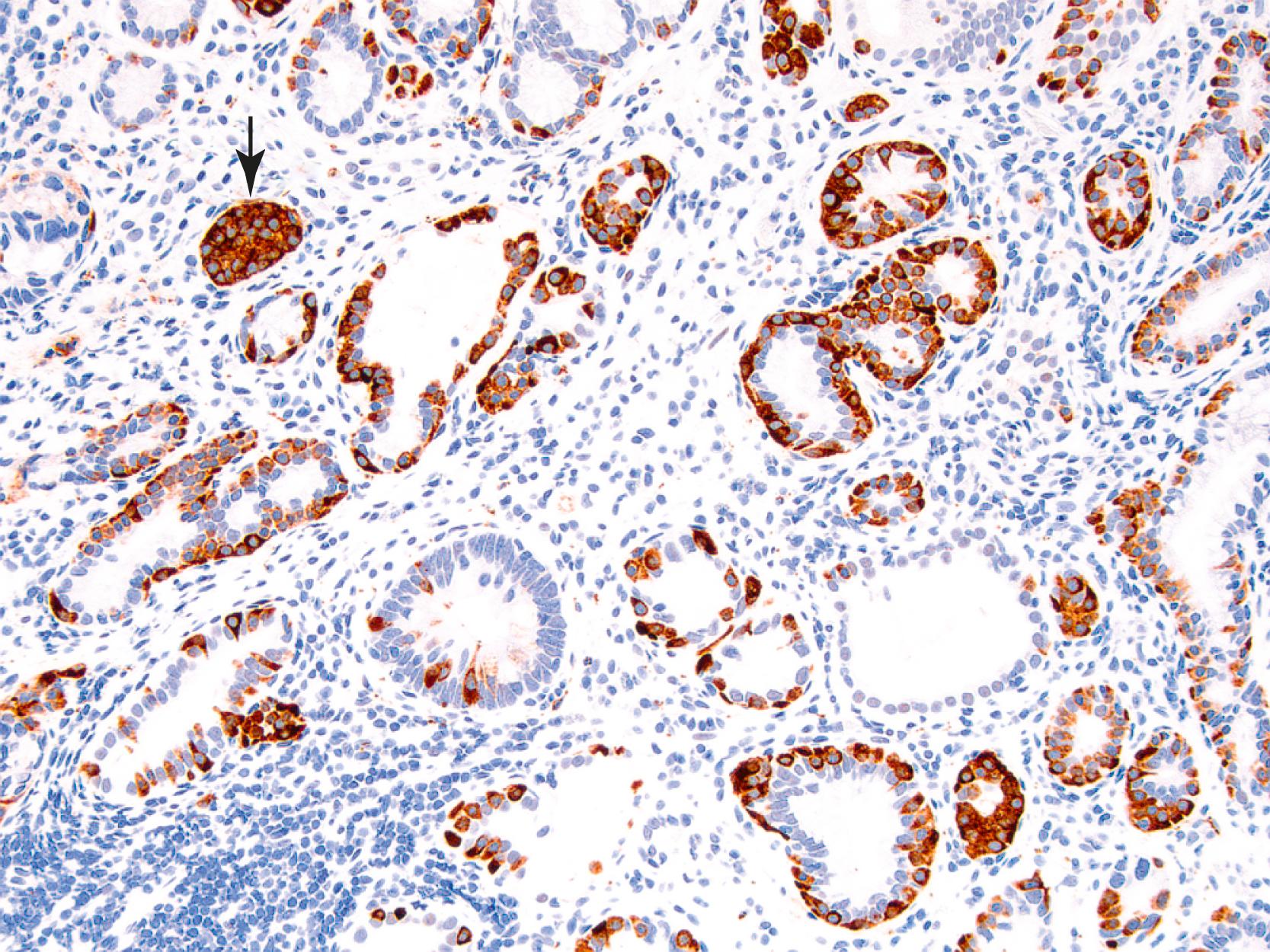
Another example of incipient NET occurs in the pancreas, multiply in patients with multiple endocrine neoplasia type 1 (MEN-1), vHL, Mahvash disease, and similar “adenomatosis” entities. These patients often develop numerous microscopic nodules that appear to be precursor lesions. Larger ones (<0.5 cm) are referred to as microadenomas or micro-NETs ( Fig. 29.2 ). Often these can be distinguished by their different morphology from background islets, a fibrous band surrounding them, and often clonal labeling with one of the pancreatic hormones, as opposed to normal islets, which typically show the presence of multiple hormones in an established distribution by immunohistochemistry. As in the gastric ECL cell proliferations, it is often difficult to appreciate where “hyperplasia” ends and true autonomous proliferation of neoplasm begins.
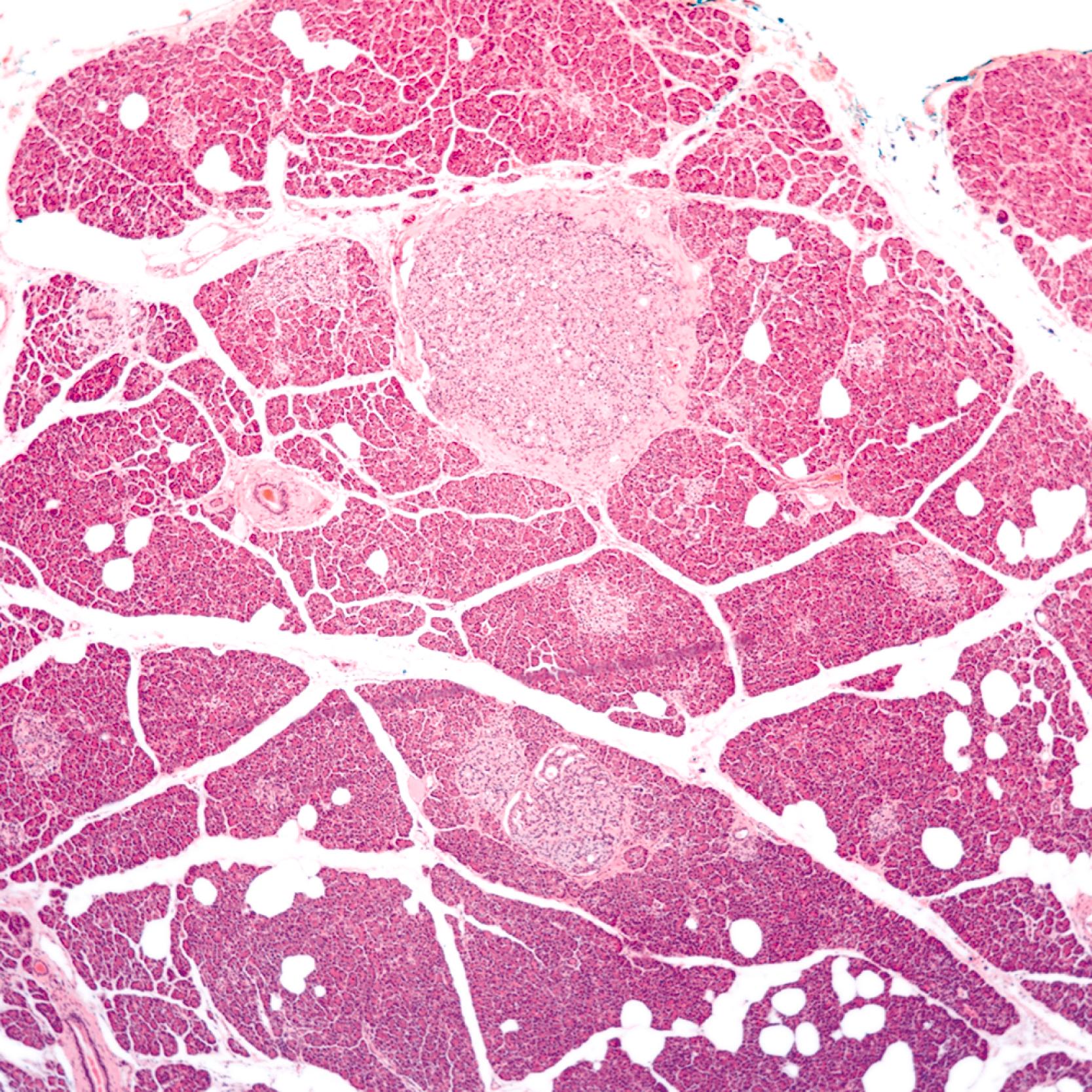
Incidental minute foci of NE cell clusters encountered in the wall of the appendix are also probably examples of the same phenomenon ( Fig. 29.3 ). There are no established guidelines for the terminology or classification of such lesions, and there are no known underlying medical or genetic conditions that predispose to such proliferations. Patchy small clusters that measure less than 1 mm are typically reported as incidental neuroendocrine cell proliferation, and a comment regarding their presumed benign nature should be provided. These can be distinguished from true NETs by the small number of cells in each cluster, lack of coalescence of the clusters, and absence of micronodule formation.
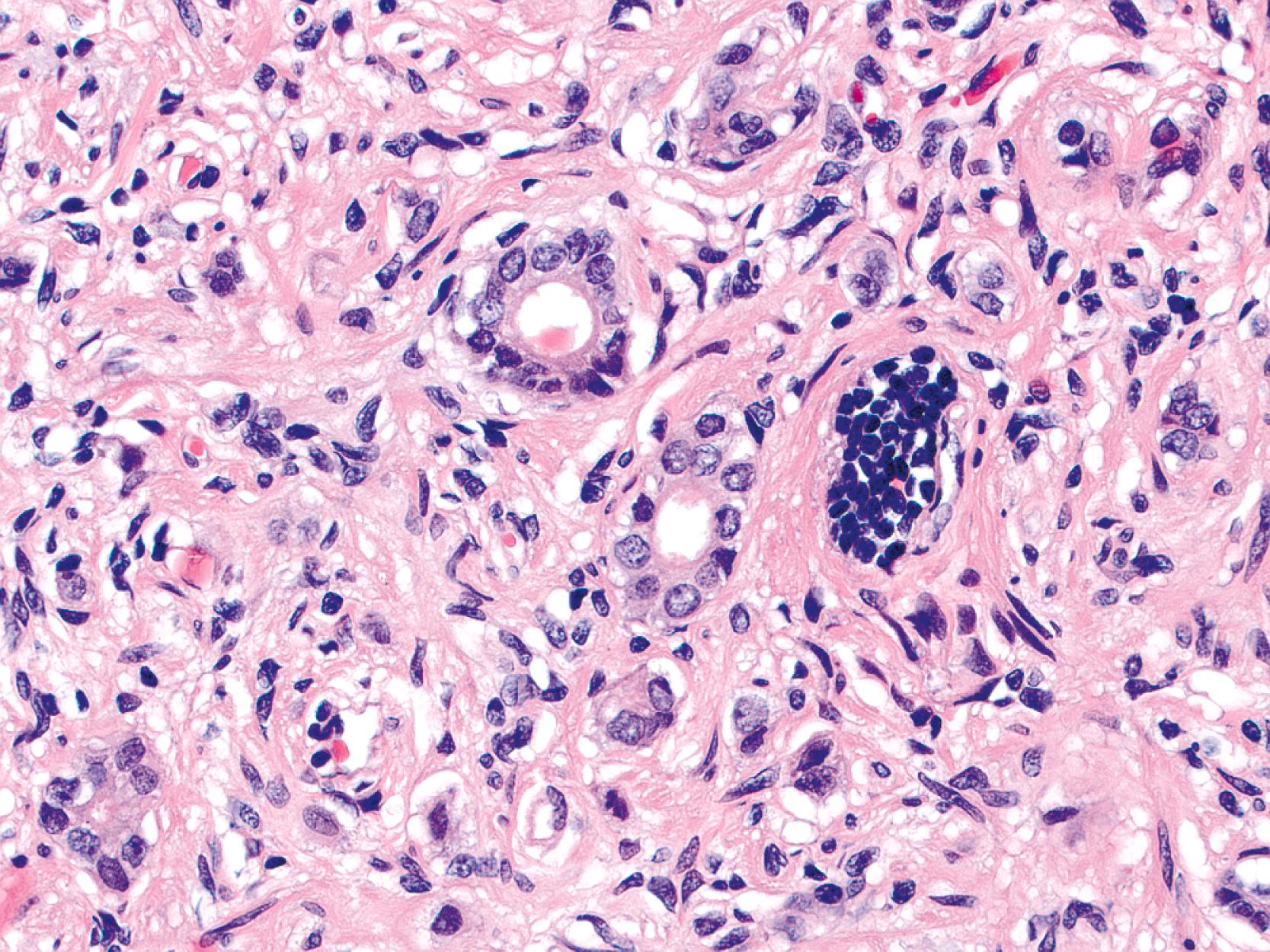
Another set of lesions that are increasingly recognized are those associated with adenomas of the GI tract. These occur as small clusters or cords typically forming a thin band at the base of the adenoma. Often the adenoma component is rich in NE cells within the glands in the very same area, leading to speculation that these NE cell proliferations are induced by the local milieu of the adenoma. Typically, these do not exhibit the features to qualify as NETs; similar to the gastric and appendiceal proliferations described earlier, they do not form a recognizable tumor and characteristically are composed of a small number of clusters and cords, each composed of a few cells. Incidental NE cell proliferations seen in mucosal biopsies of transplant patients who have undergone drug treatments as well as those occurring in injured mucosa of inflammatory bowel disease are probably representative of the same phenomenon.
In the following section, the general characteristics of WDNETs of the GI tract and pancreas will be reviewed, followed by a separate discussion of site-specific findings, with emphasis on how they diverge.
Unlike in the lungs, the vast majority of neuroendocrine neoplasms (NENs) in GI/pancreatobiliary tracts are WDNETs. Compared with glandular neoplasms, these are rare, with an estimated annual incidence of 1 to 2 per 100,000. They represent 2% of all tumors of the GI tract. Gastroenteropancreatic neuroendocrine tumors (GEP-NETs) account for 75% of the total proportion of NETs in the body. The increase in incidence of NETs is attributed to the improved diagnostic procedures and increased pathological diagnosis of less differentiated tumors. If the minute ECL cell proliferations in the stomach are disregarded, the ileum and appendix are the most common sites for established NETs, but they can occur in any portion of the GI tract. However, NETs are very uncommon in the esophagus ( Table 29.1 ).
| Site | Localized % | Regional % | Distant % |
|---|---|---|---|
| Stomach | 68 | 3 | 7 |
| Small intestine | 36 | 36 | 22 |
| Appendix | 55 | 29 | 10 |
| Colon | 39 | 27 | 25 |
| Rectum | 81 | 2 | 2 |
Being slow-growing and less infiltrative than ordinary carcinomas (and thus often allowing adaptive processes to take place), NETs are less likely than adenocarcinomas of the corresponding site to present with local symptoms. Instead, they often present with symptoms caused by the hormones they secrete, or they are detected incidentally during workup for other conditions. Some come to attention at an advanced stage with metastasis. Thus the clinical presentation of WDNETs is highly dependent on the site and the cell type. For example, appendiceal primary tumors are often detected incidentally during appendectomy, either as clinically silent small tumors or as the cause of the appendicitis. In contrast, ileal tumors are often not detected until they are metastatic, presumably because they do not lead to local symptoms and remain undetected by routine endoscopy. They are associated with serotonin secretion, and when they metastasize, decreased hepatic metabolism may lead to classical carcinoid syndrome (flushing, diarrhea, asthma, tricuspid regurgitation, and other symptoms). Different functional NETs typically present at different clinical stages. For example, most pancreatic insulinomas manifest early with a set of symptoms and signs called the Whipple triad ; thus the majority of pancreatic insulinomas are smaller than 2 cm at the time of diagnosis. In contrast, most pancreatic glucagonomas only become symptomatic when the tumor is already fairly large. The severity of the disease and clinical course (and thus prognosis) are also significantly influenced by the type of hormone produced. For example, the diarrhea caused by VIP-producing tumors (watery diarrhea, hypokalemia, and achlorhydria [WDHA syndrome]) can be debilitating and difficult to control and may even lead to death.
Some WDNETs come to clinical attention at another site based on the effects of their secreted hormone. For example, gastrinomas may lead to peptic ulcers of the duodenum or stomach (Zollinger-Ellison syndrome), or the gastrin they produce may exert a trophic effect on gastric ECL cells and lead to gastric WDNETs.
Gastrinomas also warrant a special note when they arise in the duodenum as an example of an “occult” primary tumor. There, they often present with very small primary tumors that lead to metastases and gastrinoma syndrome, in which the primary is often undetectable, not only clinically but also grossly, composing a minute focus in the duodenal wall or within the “gastrinoma triangle.” In fact, in some cases, they present with a large peripancreatic lymph node tumor (presumed to be a metastasis), and no primary tumor can be documented by extensive sampling of the tissues from the triangle, which has led to the question of whether there are true “primary nodal gastrinomas.”
Other characteristic clinical presentations should bring the possibility of WDNETs to mind. For example, if there is a large mass in the root of the mesentery without an obvious primary tumor elsewhere, then a GI WDNET, especially of ileal origin, must be considered. Similarly, a WDNET may be the culprit if a very large solitary mass in the liver is encountered without an overt primary tumor, and the patient’s liver and general condition are relatively good.
WDNETs may not only lead to syndromes by secreting hormones, but they themselves may be a manifestation of a genetic syndrome. Eighty percent of MEN-1 patients develop pancreatic neuroendocrine tumors (PanNETs), often in the background of multifocal proliferative changes in the islets. Neurofibromatosis may also lead to WDNETs, including the rare but distinctive ampullary somatostatinomas (glandular psammomatous WDNET of the ampullary region). Twenty-five percent of patients with ampullary somatostatinomas prove to have neurofibromatosis. , In patients with synchronous NETs and GISTs or neurofibromas, neurofibromatosis should be a strong consideration. In vHL syndrome, PanNETs often exhibit clear cytoplasm, presumably as a result of the well-known predilection of vHL patients to develop clear cell tumors with accompanying alterations in glycogen metabolism ( Fig. 29.4 ). WDNETs have also been reported in association with inflammatory bowel disease.
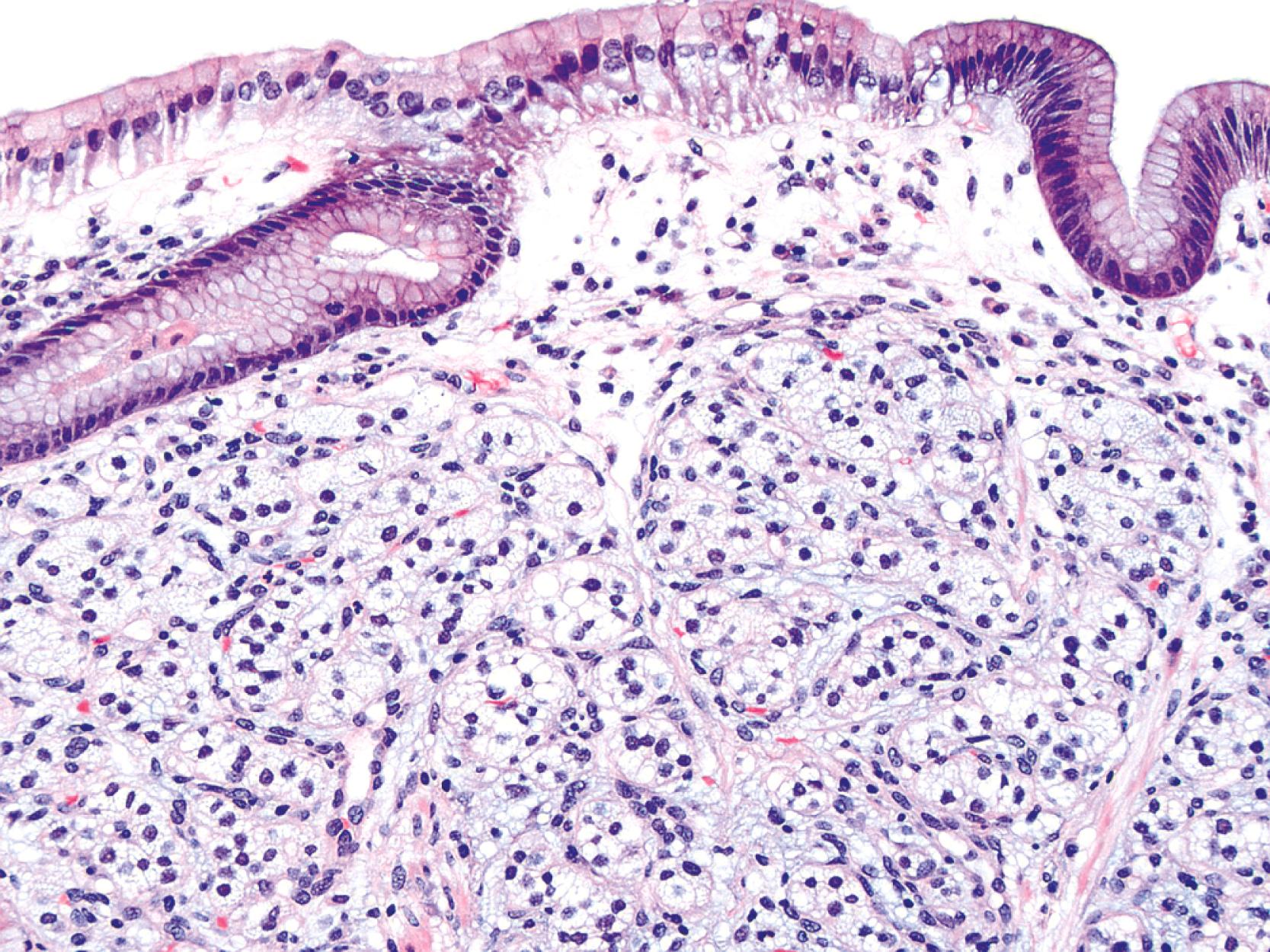
In the clinical diagnosis of WDNETs, PET scans targeting somatostatin receptors have changed the landscape greatly in the past decade. Targeting the type 2 somatostatin receptors that are widely expressed in most WDNETs, this scintigraphic scan has high specificity and sensitivity in detecting these tumors and their metastases. This is typically lacking in the PDNECs, which can be helpful diagnostically.
WDNETs are generally well-demarcated and grow with pushing borders. In fact, PanNETs, especially early-stage and indolent ones, may even have capsule-like fibrous tissue surrounding the tumor. WDNETs are typically cellular, stroma-poor tumors, and accordingly, cut sections show a fleshy, homogenous appearance ( Fig. 29.5 ). Having said that, some subsets show substantial sclerosis. The vascularity may lead to darker colors and hemorrhagic foci, especially if the tumor has been manipulated. In formalin-fixed specimens, they become yellow to white. Necrosis and mucosal ulceration can be seen in more advanced cases and are typically signs of aggressive behavior.
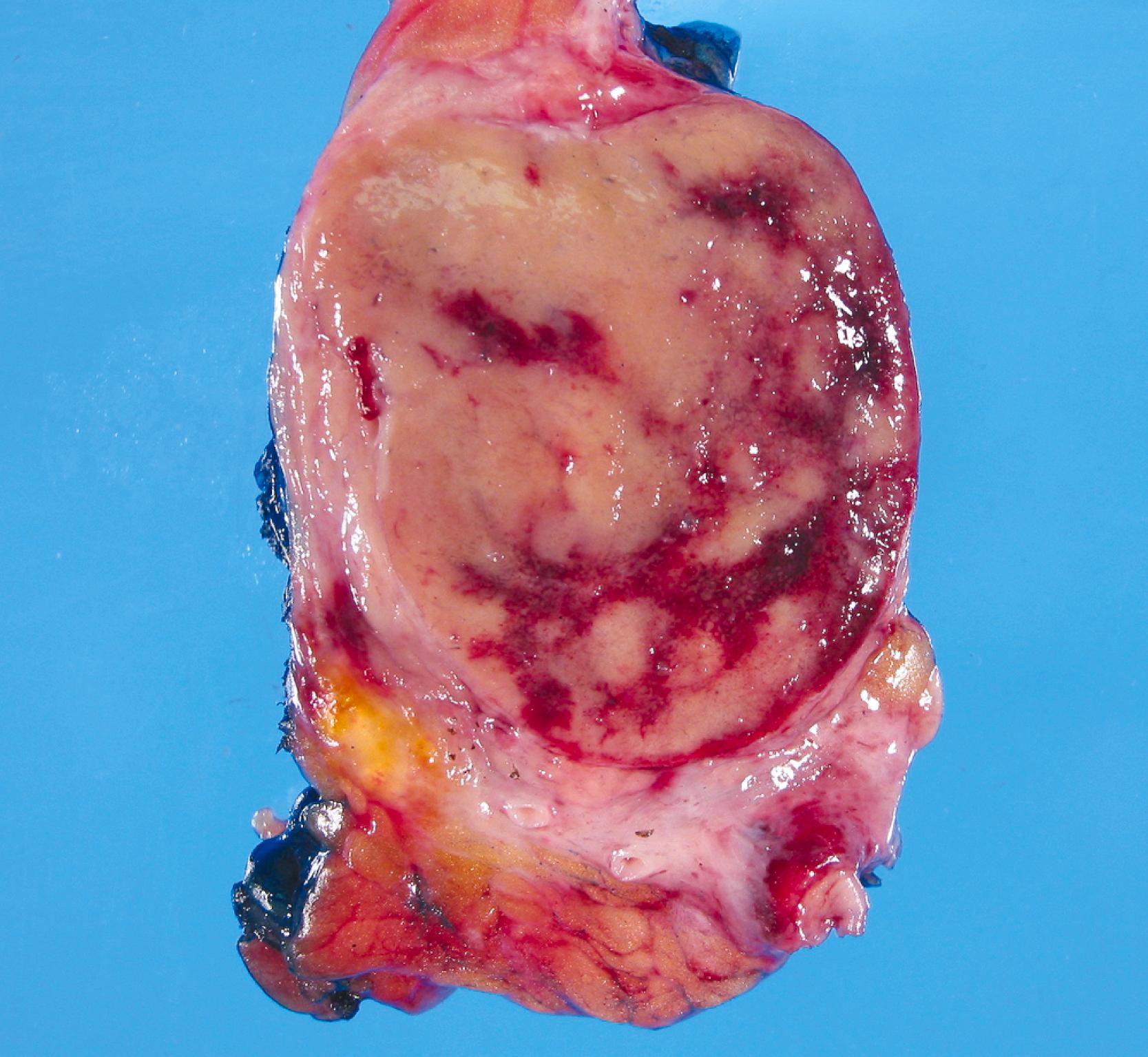
In the GI tract, WDNETs often form mucosa-covered, broad-based polypoid lesions, with the bulk of the lesion in the submucosa and muscularis. PanNETs often protrude into the peripancreatic soft tissues, although rare examples may arise from the pancreatic duct wall and appear as sclerotic lesions constricting the duct, causing secondary dilatation of upstream ducts, thus mimicking intraductal papillary mucinous neoplasms (IPMNs). ,
WDNETs are typically solid tumors. However, in the pancreas, some examples (up to 10%) present as a cystic mass as a result of central degeneration, leaving a variably-sized cuff of histologically conventional NET clinging to the cyst wall.
As discussed previously, NETs arising in the background of genetic or medical disorders may be multifocal. In fact, in the pancreas, a multifocal solid tumor often proves to be a NET.
Typically, WDNETs are composed of uniform, round cells, with a moderate amount of cytoplasm and coarsely granular, “salt-and-pepper” chromatin ( Fig. 29.6 ). The latter finding is probably the most specific diagnostic feature of these tumors. Cytoplasmic granules may be evident and are especially prominent in mid-gut examples, along with melanin/lipofuscin type pigment ( Fig. 29.7 ). The cells grow in nests, acini, rosettes, ribbons, festoons, and trabeculae ( Fig. 29.8 ). Gland formation by the tumor cells is also not uncommon. Delicate vasculature is another hallmark, especially in cases with a prominent nested pattern ( Fig. 29.9 ). Artifactual clefting around the nests is common, particularly in the intestinal examples.
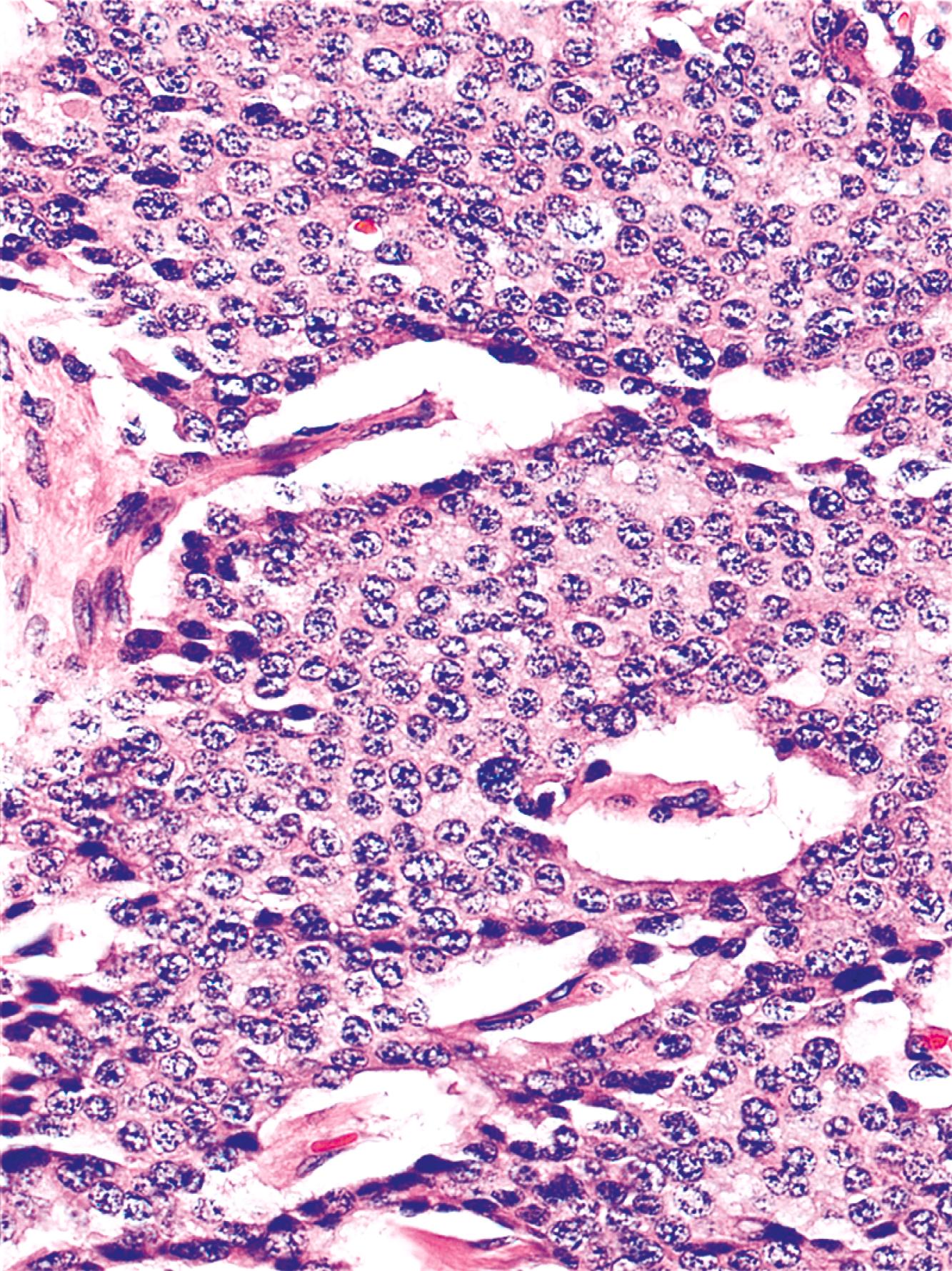

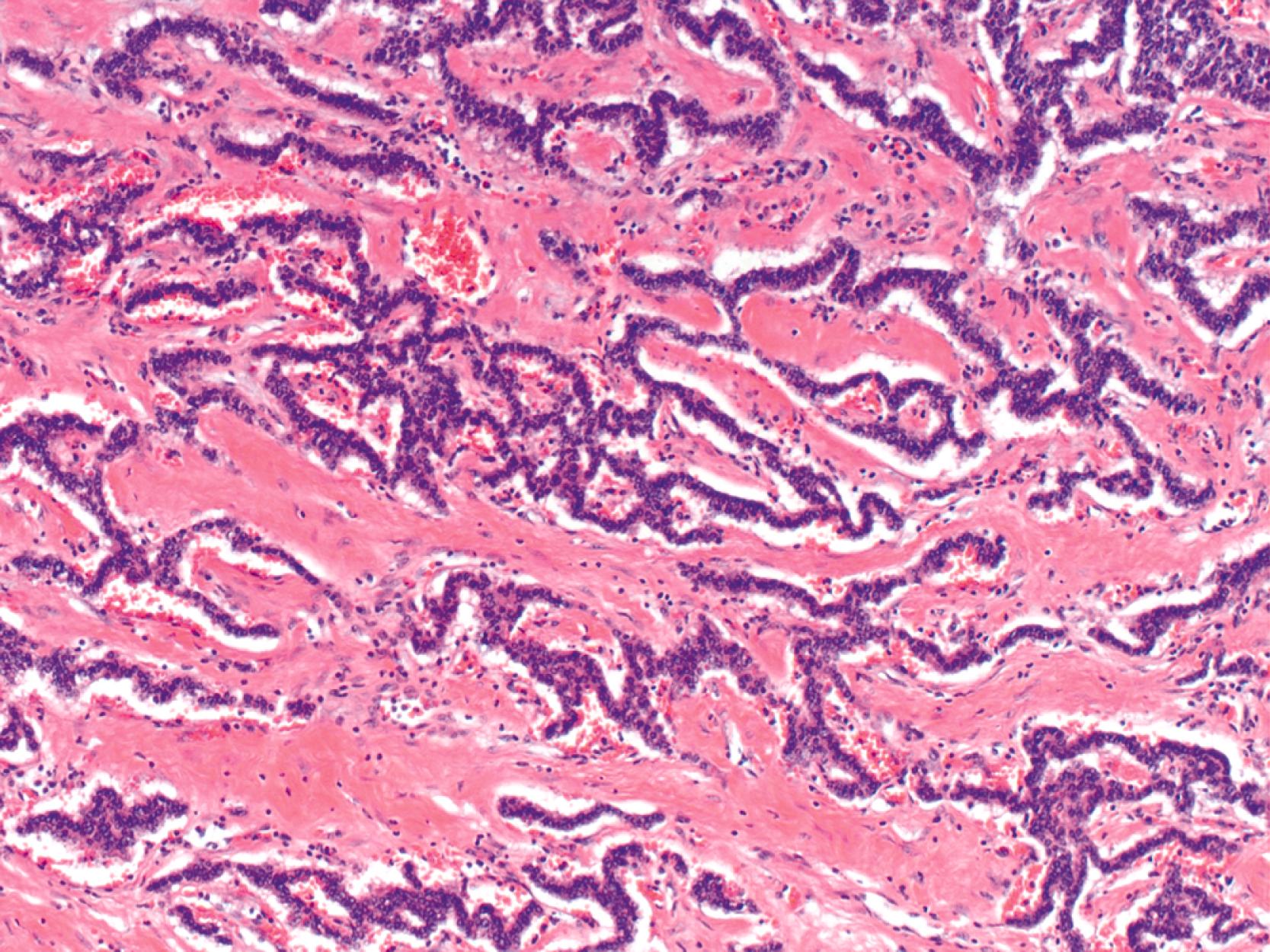

There are numerous morphological variants in WDNETs. In most of these, at least one of the three classic NE morphological characteristics (cellular monotony, cytoplasmic abundance, and salt-and-pepper chromatin) is retained. These variants may be important to recognize because some create substantial diagnostic challenges. There is emerging evidence that some may also have clinical significance. In a recent study in the pancreas, these variants were found to cluster in three groups, as described in the following paragraphs.
WDNET variants that have abundant cytoplasm often with prominent nucleoli in a manner seen in metabolically productive cells such as adrenocortical tumors (“lipid rich variant) ( Fig. 29.10 ) or in hepatocytes (“hepatoid variant”) and oncocytic cells (“oncocytic variant”) , , were found to show a tendency to be larger and show more aggressive behavior in the pancreas. They also tend to show a more diffuse growth pattern or broad bands rather than small nests and trabeculae characteristic of more ordinary NETs. Some have dyscohesive growth and resemble solid-pseudopapillary neoplasms. Among these, the lipid-rich variant sometimes lacks the nuclear features characteristic of NETs, potentially leading to misdiagnosis. In other NETs, the cytosolic contents, mostly intermediate filaments, may push the nucleus to the periphery and create a rhabdoid or plasmacytoid , , appearance ( Fig. 29.11 ), also mimicking signet-ring cells. Intracellular mucin is lacking, however. Other NETs, especially in the pancreas but also occasionally in the stomach or rectum, have oncocytic features characterized by abundant acidophilic granular cytoplasm and single prominent, eccentric nucleoli ( Fig. 29.12 ). A variation in this theme is the hepatoid variant, which may show not only the characteristic histomorphological features of hepatocytes, but may even express reliable hepatocytic markers including arginase and HepPar1. When metastatic to the liver, these oncocytic and hepatoid NETs may easily be mistaken for hepatocellular carcinomas. Some NETs have high nucleus-to-cytoplasm ratio that imparts a “small blue cell” appearance. These cases also often have a more diffuse growth pattern, which further accentuates the concern of a high-grade neoplasm, especially based on small biopsies. Ki67 labeling index is helpful in establishing the well-differentiated nature of such examples. As mentioned previously, these NET variants that resemble metabolic cells and/or show more diffuse growth pattern have been found to be more aggressive in some studies , and thus may warrant closer attention.



In contrast, the variants that exhibit degenerative changes and more mature elements or organoid patterns appear to be more benevolent. “Endocrine atypia” characteristic of normal endocrine organs may also be seen in WDNETs, represented as large, bizarre, pleomorphic nuclei with smudgy chromatin ( Fig. 29.13 ). This is akin to the degenerative atypia seen in “ancient” schwannomas or “symplastic” leiomyomas. This kind of pleomorphism in NETs can lead to misdiagnosis as more aggressive neoplasms, but some studies have shown that they tend to be smaller and lower grade, and limited data indicate that they may be less aggressive. , Similarly, NETs that have prominent mature ducts often raise concern for mixed adenocarcinoma, although the tumors displaying these findings are often small and less aggressive. In the pancreas, where these are mostly encountered, they have been also termed ductulo-insular PanNETs. , , The nature of the ducts is debatable; however, they are often so prominent that they give the impression that they are beyond mere entrapment of normal ductal glandular units of the background tissue. They also are mature, and they do respect the boundaries of the lesion, often stopping at the margins of the NET confined within the NET itself, which help distinguish them from an adenocarcinoma. Another variant that appears to have more benevolent characteristics is the paraganglioma-like variant. , These can be indistinguishable from a paraganglioma, including the focal presence of sustentacular-like cells in some, but the tumor expresses keratin.

Stromal alterations may also add variety to the morphological spectrum of WDNETs. In some cases, these already hypervascular tumors become massively congested, or hemorrhagic, creating a peliotic appearance. In others, particularly in the stomach, the stroma can exhibit myxoid features ( Fig. 29.14 ). Although most WDNETs are fundamentally stroma-poor tumors, they can exhibit intense stromal sclerosis, especially ileal NETs and PanNETs, which secrete serotonin ( Fig. 29.15 ). In some cases, amidst the sclerotic changes, the cellular infiltrates of NET may acquire a cordlike pattern that can be very similar to mammary tubulolobular carcinoma.


Rosette or glandular formations can be prominent in some WDNETs. In fact, in ampullary somatostatinomas, gland formation is so characteristic that the name glandular psammomatous NET of duodenum has been applied ( Fig. 29.16 ). , , , They also often entrap the ampullary ductules, which, along with the glands formed by the tumor, can be mistaken for an adenocarcinoma. A variant of WDNETs in the appendix (“tubular carcinoid”) is also characterized by gland formation, and considering that NE marker expression may be more limited in this variant, it can be difficult to distinguish from an adenocarcinoma. Ileal WDNETs also tend to have glands, which are often prominent in the superficial/mucosal component of the tumor and are often located at the periphery of the individual nests.

Unlike pulmonary WDNETs (carcinoids), spindle cell morphology is very uncommon in GI and pancreatic NETs. Occasionally, gastric WDNETs may have vague spindle cell morphology. In the ampullary region, trabeculae with prominent elongated cells should raise the question of gangliocytic paraganglioma in which the NE component often exhibits this morphology.
Appendiceal tumors characterized by the presence of goblet cells form a distinct category now termed goblet cell adenocarcinoma and are discussed separately later in this chapter.
WDNETs are defined by the presence of NE granules, which in most (but not all) cases can be highlighted by the widely available NE markers, chromogranin, synaptophysin, and CD56. Among these, chromogranin is the most specific, but its sensitivity is lower. Rectal and a subset of appendiceal NETs (tubular examples) can be devoid of chromogranin A, which is the target of most available chromogranin antibodies. Synaptophysin, on the other hand, is very sensitive but less specific, with a variety of mimickers showing potential expression of this marker. CD56 is even less specific. For the diagnosis of WDNETs, these markers may not be needed, considering the morphology is often distinctive enough. They may, however, become necessary in some of the morphological variants described earlier and of course for the diagnosis of poorly differentiated NE carcinomas (discussed later). INSM1 has attracted attention recently as a marker of NE differentiation with moderate sensitivity and high specificity.
NETs also show epithelial differentiation, and as such they express keratins in the vast majority of cases; however, the type and degree of keratin positivity may vary. Although wide-spectrum keratins are commonly positive, both CK7 and CK20 expression is relatively infrequent. CK19 can occasionally be expressed in PanNETs and has been used as an adverse prognostic marker.
Recently, nuclear transcription factors involved in the embryonic development of site-specific NE cells have been employed in determining the primary site of a WDNET, but they are not entirely specific. For example, CDX2 is commonly expressed in the NETs of GI tract origin ( Fig. 29.17A ). Islet-1 (isl1) is expressed commonly in PanNETs but is also commonly present in rectal WDNETs ( Fig. 29.17B ). , Pancreatic duodenal homeobox 1 (PDX-1) has been shown to be a marker of pancreatic NETs both in primary and metastatic sites, but the specificity of this marker is not known. TTF1 expression is generally uncommon in both pancreatic and GI WDNETs, but its sensitivity for pulmonary carcinoid tumors is quite limited. It should be kept in mind that TTF1 is expressed in small cell carcinomas of any organ. Pax8 is commonly expressed in pancreatic and rectal NETs but is typically absent in ileal NETs. As is true for the pancreatic islet cells, which express progesterone receptors and CD99 presumably due to cross reactivity, PanNETs can also express these markers. Recently, NKX2.2 has been found to be of some value in determining the origin of a metastatic NET.

The molecular pathways commonly abnormal in the adenocarcinomas of respective organs are typically unaltered in WDNETs, whereas they are often also deranged in PDNECs. For example, p53 overexpression and loss of SMAD4 (DPC4, which is commonly altered in pancreatic adenocarcinomas) can be observed in PDNECs but are extremely rare in WDNETs. , Similar observations have been noted for loss of retinoblastoma protein. In contrast, ATRX/DAXX pathway alterations, represented as loss of nuclear expression, which are common in NETs, are seldom detected in PDNECs.
Somatostatin receptor scintigraphy is widely used in the clinical setting and has proven extremely valuable in the clinical diagnosis of WDNETs, follow-up for progression and metastasis, as well as their distinction from other tumors including PDNECs, which typically lack this marker. As the immunohistochemical antibody for SSTR2 is becoming more widely available for daily practice, its potential value in surgical pathology is being evaluated and appears quite promising. , ,
There are other immunohistochemical caveats to consider. Ileal and rectal WDNETs can express prostate-specific acid phosphatase. In fact, occasionally this may help in determining the origin of a metastatic NET. CEA is expressed in 60% of WDNETs, and CA19-9 positivity may also be seen. S100 can be positive, both nuclear and cytoplasmic, in some WDNETs, especially in the appendix and some ampullary somatostatinomas.
The value of immunohistochemical analysis of hormone production is not clear. Correlation with functional activity is highly imperfect. Additionally, many tumors have multihormonal activity and may even alter the predominant secretion over time. Therapy may also influence the type of hormone produced by the cells.
Ultrastructural detection of neurosecretory granules represented as membrane-bound dense core granules is helpful in establishing the diagnosis of WDNETs. The pattern of the granules may be helpful in determining the specific cell type ( Fig. 29.18 ). However, electron microscopy is seldom used in modern surgical pathology because of technical impracticalities and the utility of immunohistochemistry. Electron microscopy can be helpful in demonstrating NE differentiation in unusual settings such as poorly differentiated or amphicrine tumors.

NETs that arise as a result of familial syndromes (MEN-1, vHL, tuberous sclerosis, or neurofibromatosis type 1) reveal the molecular alterations characteristic of the corresponding syndrome; sporadic tumors may also show these alterations. For example, either somatic mutations or loss of heterozygosity of the MEN1 gene (11q13) and its protein product menin can be seen in gastric and pancreatic WDNETs, and loss of NF-1 (17q11; neurofibromin) may be found in somatostatinomas. It should be noted here that WDNETs of different sites have different genetic background. For example, ileal NETs are not associated with MEN-1 and vHL syndromes.
As discussed earlier, alterations of genes involved in the pathogenesis of adenocarcinomas of the GI and pancreatobiliary tracts such as p53, Her2, CDKN2A, and DPC4 are much less common in WDNETs. In contrast, recently, NETs have been found to show mutually exclusive inactivating somatic mutations of DAXX (death-domain associated protein) and ATRX (alpha thalassemia/mental retardation syndrome X-linked) genes in nearly one-half of cases; these genes are involved in a chromatin remodeling complex, believed to be critical in telomere maintenance. A subset of NETs shows somatic mutation of the genes that encode for proteins in the mammalian target of rapamycin (mTOR) cell signaling pathway and includes somatic mutations of PIK3CA, PTEN, and TSC2. Other molecules that are under investigation and seem to be abnormal in a smaller subset of cases include X-chromosome, Hsp90, IGF1R, and EGFR, among others. There are also more recently described and less well-known genetic alterations implicated in the pancreas characterized by adenomatosis (i.e., multiple variably sized NETs in the background of multiple incipient neoplasia). The prototypical example is Mahvash disease, which is a rare autosomal recessive disease with inactivating mutations in the glucagon receptor. There are other similar entities such as insulinomatosis of which molecular mechanisms have yet to be characterized. ,
There is fair amount of fidelity regarding the morphology of these tumors, thus their diagnosis is relatively straightforward in most cases. There are, however, a few situations that lead to diagnostic problems. Limited biopsies or the presence of preservation artifact sometimes leads to misdiagnoses, especially considering that they can be located at the base of the mucosa and thus may be underrepresented in the biopsy. Rosettes and tubules can be mistaken as adenocarcinoma. In crushed specimens, WDNETs may also mimic lymphoid tissue. More problematic are the rare and underrecognized variants as discussed previously. Clear cell or lipid-rich variants (see Fig. 29.10 ) are often misdiagnosed as carcinomas from the kidney, adrenal gland, or liver. WDNETs with hepatoid and oncocytic features can be mistaken for a primary hepatocellular carcinoma in the liver (see Fig. 29.12 ). A pleomorphic variant can be mistaken as a high-grade carcinoma (see Fig. 29.13 ). Tubule-forming examples (such as ampullary somatostatinomas) or ductulo-insular PanNETs often raise concern for an adenocarcinoma. Please see the corresponding organs for the more site-specific discussion of differential diagnosis.
GI and pancreatic NETs are now widely recognized as malignant neoplasms, albeit low-grade and even curable when discovered at low stage and low grade. It is the norm that WDNETs have a more favorable prognosis than the conventional adenocarcinomas of the corresponding sites. However, as more data accumulate on the long-term prognosis of these tumors (i.e., 10 years), it is clear that a significant proportion eventually recurs and metastasizes. The preferred sites of distant metastasis are the liver, lung, peritoneum, and bone. Even cases with distant metastasis may have a protracted clinical course.
This is best exemplified in the stomach, where WDNETs arising as a result of hypergastrinemia in the background of autoimmune gastritis typically follow a benign clinical course, whereas the sporadic WDNETs of the very same organ are often aggressive.
Become a Clinical Tree membership for Full access and enjoy Unlimited articles
If you are a member. Log in here